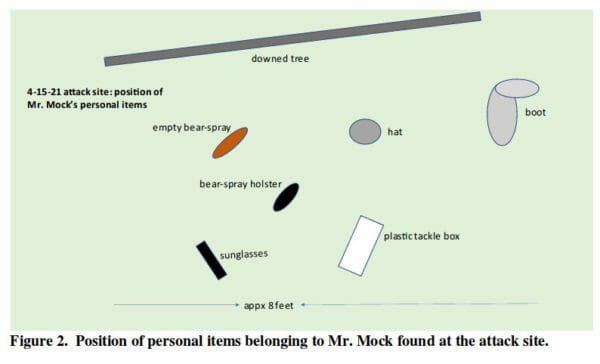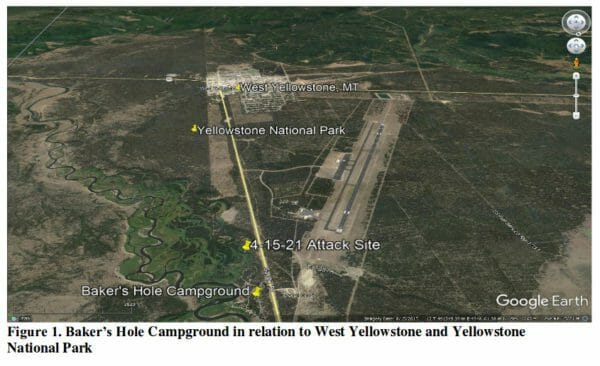
U.S.A. –-(AmmoLand.com)- On April 15, 2021, Carl Mock was attacked by a grizzly bear, just outside of Yellowstone Park. Mock was an accomplished woodsman and guide. He did not have a firearm with him. He had bear spray. He used the bear spray but was fatally injured.
This correspondent, with questions directed to Montana Fish and Wildlife Morgan Jacobsen, was able to determine bear spray had been used in the incident. Initially, the use of bear spray was reported as unknown by ktla.com:
Mock when attacked had bear spray — a Mace-like deterrent meant to protect against attacks — but officials said they did not know if he managed to use it. Bear spray canisters have safety tabs to prevent them from going off accidentally and the safety tab on Mock’s bear spray was off, Jacobsen said.
Eight months later, the investigation of the incident is over.
Ktvh.com reports the investigation confirms bear spray was used. Although the attack was fatal, the lead investigator, Hillary Cooley, is reported as characterizing the use of bear spray as helpful. From ktvh.com:
Cooley says the incident again shows the need for safety precautions, even close to town. While bear spray helped curtail this attack, carcasses can present a real hazard in grizzly country.
Another report indicates the full can of bear spray was discharged in the incident. From gohunt.com:
Investigators say he had brought fishing gear and a camera to the closed campground and likely the surprised the grizzly bear around 3:30 p.m. He was able to discharge a full can of bear spray during the attack and call 911 to report where he was.
The full investigative report makes clear the bear spray was deployed against the grizzly bear during the attack. From the full investigative report:
Due to the empty cannister of bear-spray and the bear-spray residue on the bear carcass(hair), Mr. Mock had obviously been aware of possible grizzly bear encounters in the area and had deployed his bear-spray at the bear. It is not known if he bear-sprayed towards the bear prior to the bear contacting him or at what points during the attack he used the spray. During field and lab investigations, it was confirmed that the bear had substantial bear-spray residue on its hair. Additionally, the overall effects of the bear-spray to the bear are not known but the bear had quit attacking Mr. Mock, indicating the bear was affected by the bear-spray.
It is common for grizzly bears to stop attacking humans after they stop moving.

Recommendations from the report on self-defense:
- Carry and know how to use self-defense….bear-spray and or firearms
- It is always recommended to carry bear-spray even if individuals carry firearms.
The report identifies the bear spray used:
*The can of bear spray was the UDAP brand, 7.9ounce, Expiration 12/2023 S/N P1711-071135).

A digital camera with a telephoto lens was recovered at the attack scene, but no photographs of the Baker’s hole campground area were found on the memory card for the camera. The moose carcass found 47 yards from the attack site was not noticed by the Search and Rescue team or by the helicopter during the initial rescue and recovery of Carl Mock.
This attack is one of a growing number where bear spray was used by the victim, and the victim was killed. Others include the killing of Daniel Schilling in Alaska and the Mark Uptain tragedy in Montana. There are others where bear spray was used by other people, but the victim was still killed, such as the death of Erin Johnson in the Pogo mine incident in Alaska, the death of Stephanie Blais in Saskatchewan, Canada.
These incidents reveal bear spray to be far from the cure-all initially claimed in numerous early articles. Those articles were based on inappropriate comparisons of studies involving firearm effectiveness and bear spray effectiveness in wildly different conditions.
About Dean Weingarten:
Dean Weingarten has been a peace officer, a military officer, was on the University of Wisconsin Pistol Team for four years, and was first certified to teach firearms safety in 1973. He taught the Arizona concealed carry course for fifteen years until the goal of Constitutional Carry was attained. He has degrees in meteorology and mining engineering, and retired from the Department of Defense after a 30 year career in Army Research, Development, Testing, and Evaluation.

